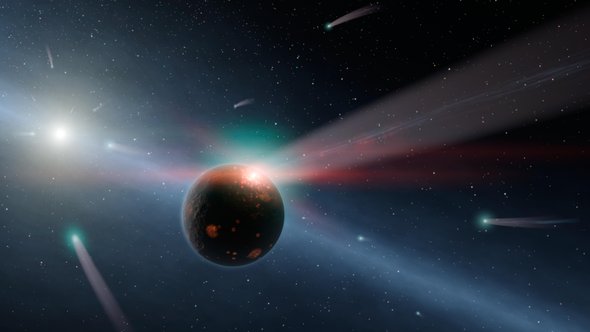This content has been archived. It may no longer be relevant

Far beyond our sun, astronomers have discovered comets bombarding a young solar-type star—and possibly its inner planets
A rain of comets is pouring down on a faraway young star, giving astronomers a new view of a process that shaped our own solar system billions of years ago.
When Earth was a young planet, cometary debris battered its surface, carrying organic material that may have helped life arise on our rocky world. In recent years scientists have spotted indirect evidence for a similar process around Eta Corvi, a solar-type star some 59 light-years away that is slightly larger and three times younger than our own sun. Now newly observed flickers of gas thought to emanate from comets evaporating in the heat of the star are providing stronger evidence for both hidden planets and cataclysmic impacts.
Detected by University of California, Berkeley, astronomer Barry Welsh and his colleague Sharon Montgomery of Clarion University in Pennsylvania, these whiffs of gas may have a deep albeit indirect connection to our own cosmic home. When our sun was the same age as Eta Corvi, most theorists believe gravitational interactions between our solar system’s outer planets swept the icy leftovers of their formation inward to pummel Earth and the other rocky planets. This “late heavy bombardment” (LHB) may have been crucial for Earth’s habitability and our very existence here, delivering life-giving water and organic compounds from deep storage in the outer solar system. And something much like it seems to now be occurring around Eta Corvi. Welsh calls the star a “potential solar system in the making.”
Read the Complete Article
Courtesy of Nola Taylor Redd Scientific American

